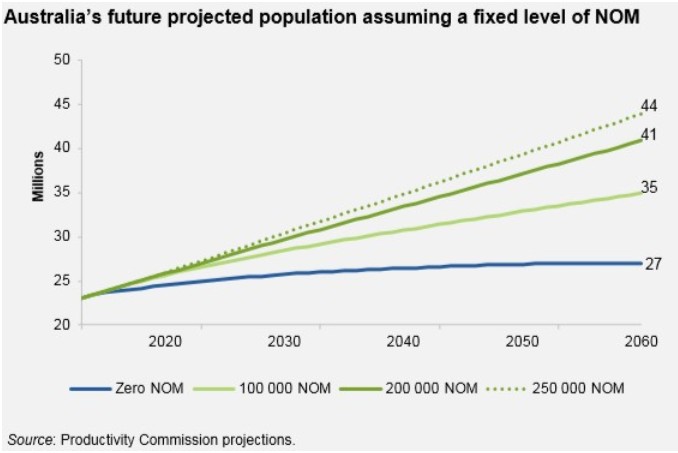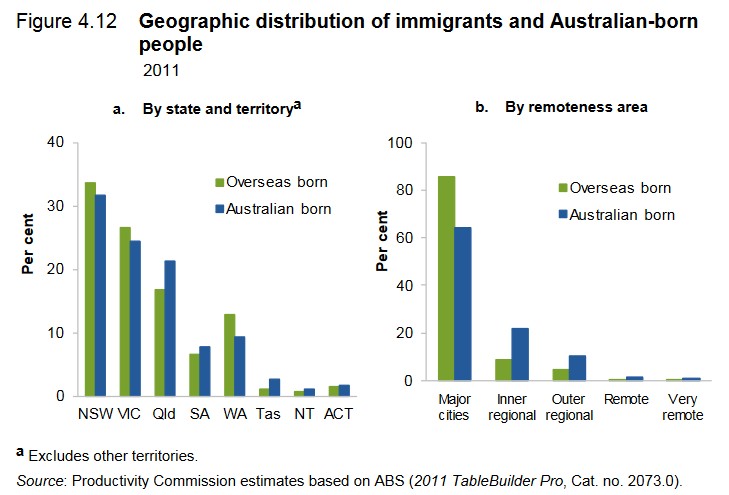In 2003 I arrived at the Australian Treasury to begin my career as an economist.
Upon arriving at Treasury, I was introduced to the “three P’s” framework by then Treasury Secretary, Dr Ken Henry.
According to this framework, we were told that Australia must: 1) boost productivity; 2) raise workforce participation; and 3) increase the population via skilled migration, if the nation was to continue to enjoy rising living standards.
I never bought in to the three P’s framework, instead preferring that it was pared back to the “Two Ps” of productivity and participation.
Population growth’s impact on living standards is highly questionable. While it certainly does raise headline GDP (more inputs equals more outputs), there are significant doubts over whether it raises per capita GDP, while also placing greater pressure on the environment, pre-existing infrastructure and housing, as well as Australia’s fixed endowment of mineral resources (see here for a detailed run-down of the issues).
In July 2016, it seemed that Ken Henry had his Damascus moment warning about Australia’s excessively high population (immigration) growth [my emphasis]:
Here are a few things most Australians know. They know that the budget is unsustainable and that a government that refuses to address the quality of the tax system is not going to fix the problem.
They know our population is growing at a rate that exceeds the capacity of traditional models of planning, building and pricing access to the nation’s infrastructure and housing. They know that productivity growth will not be boosted significantly without a substantial contribution from economic infrastructure and without further investments in education.
Ken Henry then doubled down in December 2016 warning us that Australia’s break-neck population growth will crush living standards unless Australia’s governments embark on a massive infrastructure building program:
The Australian population is growing by something like 400,000 a year. Think of it: a new Canberra every year between now and the end of the century. Or, put it this way, every five years building a brand new city from scratch in Australia for 2 million people.
Or put it this way: building a whole new city the size of Melbourne every decade between now and the end of the century…
My observation in Sydney and Melbourne today, is that people already think, with very good reason, that the ratio of population to infrastructure is too high. But we have set ourselves on a journey that implies an increase in that ratio. An increase in that ratio that is associated with more congestion, longer commute times to work, increasing problems with respect to housing affordability…
That means that we have to take an interest in traffic congestion, housing affordability, urban amenity and environmental amenity, including climate change mitigation and adaptation…
But then last year Ken Henry backed down somewhat, claiming that Australia simply needs to shift population growth to the regions [my emphasis]:
[Henry] conceded many people only saw the “downside” of higher population growth, such as congestion and expensive housing.
“We’re in a period of much stronger population growth now, and it’s going to go on for decades”, he told BusinessDay, speaking from Mildura alongside chief executive Andrew Thorburn.
…if our burgeoning population is properly supported by infrastructure investment, he said a bigger Australia could be a historic chance to develop regional areas.
“There is an unprecedented opportunity for many regions in Australia now if they’re backed by the right expertise, if they’re backed with the right infrastructure, if they’re backed with the right access to finance from banking partners who understand them, and understand their future, and who are committed to their community,” he said.
If these things occurred, Dr Henry said, “I think there’s an extraordinary development opportunity here for Australia”.
NAB is the country’s biggest agricultural and business lender, and the comments come as it looks to cement its position in these markets, after in recent years selling poorly performing overseas banks.
In Friday’s speech, Ken Henry again mentioned the population pressures afflicting the Australian people and environment via the federal government’s mass immigration program:
It’s nearly 10 years since my colleagues… and I were commissioned to conduct a comprehensive review of Australia’s tax and transfer systems.
Our deliberations were set against the backdrop of several major challenges confronting Australia; all of which present as even more serious today.
First, a strongly growing and rapidly ageing population…
…deterioration in housing affordability, increasing urban congestion, and worsening access to high quality education at all levels.
…an extended period of large current account deficits and the possibility of further international financial volatility, underpinning the case for a stronger national saving effort.
… growing environmental pressures, including land degradation, loss of fragile ecosystems, species decline, unsustainable water use and climate change.
…the fact we have the highest rate of population growth in the developed world has obvious implications for the utilisation of the nation’s infrastructure, including roads. Yet the revenue bases being relied upon to finance road construction and maintenance are falling relative to the total tax take, and we have almost no functional ability to manage congestion. This is unsustainable.
Ken Henry as the policy doyen would have been honest enough to acknowledge that a primary driver behind the “much stronger population growth now” and into the future, as well as the deteriorating natural environment, housing affordability, infrastructure, and Australia’s current account deficit, is the federal government’s mass immigration program, which was ramped-up massively from the early-2000s, as shown in the next chart:

It is this mass immigration program that has Australia’s population projected to grow to around 40 million people mid-century – some 13 million more than would occur under zero net overseas migration:

Ken Henry the policy doyen would have acknowledged that Australia’s immigration intake is now far too high and should be at least halved to take the pressure off infrastructure, housing and the environment.
Ken Henry the policy doyen would also have acknowledged that Australia has attempted to decentralise for a century without success (other than the creation of Canberra), and the hope of shifting Australia’s population growth to the regions is little more than a pipe dream.
The fact is, migrants have always chosen to settle in the big cities of Melbourne and Sydney, rather than the regions:

So what makes Ken Henry believe that migrant settlement patterns will magically change in the future?
Of course, we are not dealing with Ken Henry the policy doyen anymore, but Ken Henry the bank lobbyist. And what better way is there to lazily boost bank profits than to keep the throttle on mass immigration and endless dumb population growth, in the process perpetually growing NAB’s customer base?
As noted by Ken Henry himself last year, while ordinary Aussies dislike mass immigration, big business loves it:
Research NAB carried out earlier in the year showed that among our customers there’s not wholesale support for a larger Australia. For many, the prospect of a higher Australian population means more stress in the ability to buy a house, to live where you want to live, to get to work with a reasonable commute time. And many in the community are also concerned about our ability, as a nation, to maintain norms of Australian social and economic inclusion, and to continue to provide access to high quality services in areas such as healthcare and education.
These concerns are playing out against a backdrop of rapid technological advancement that’s seeing the digitalisation and automation of many aspects of our lives, including in the workplace – and with it, growing concerns about job security.
But what is the business perspective? The same NAB research showed that most of our business customers would strongly prefer a larger population, which supports better business growth.
That’s right. Private businesses like toll road operators, retailers, banks and property developers get to enjoy the easy growth in revenue and profits that come from an ever expanding customer base, whereas households suffer from the increased competition and reduced bargaining power at work, smaller and more expensive housing, rising infrastructure costs, longer and more expensive commutes, and a degraded environment.
Will the real Ken Henry please stand up for Australia? Or is he is now just another shameless rent-seeker for the growth lobby.
Addendum:
A reader has pointed me to a statement by Ken Henry in 2011 claiming that Australia’s “sustainable population” was just 15 million – some 10 million below current levels:
KEN HENRY: A sustainable population for Australia, well I don’t know, maybe 15 million, something like that, that’s one-five not five-zero.
It’s evident in the environmental degradation that one sees, the loss of biodiversity, species extinction and so on, it’s very clear that the population growth that we’ve experienced to date, to give us a population of 21, 22 million has not been sustainable population growth in that sense.
QED.

